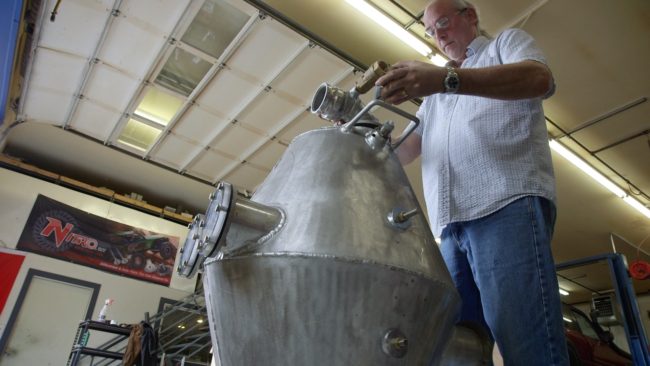
Cleaning up after a major oil spill is a huge challenge. After the BP Deepwater Horizon disaster, for example, the federal government estimates responders removed only about a quarter of the nearly 5 billion barrels of oil released.
One Alaskan thinks he’s figured out a better way to do it. He doesn’t work in a lab, he doesn’t have any fancy degrees and he’s not backed by the government or a big company. But some experts think he might be on to something.
His name is Kevin Kennedy, and he spends a lot of time poking around what he refers to as his “mad scientist den.”
It’s a garage that smells strongly of oil, cluttered with mechanical parts and tools, right behind Kennedy’s house in South Anchorage. Here, Kennedy has poured his soul — and, he says, his retirement — into developing a new kind of oil spill cleanup technology.
Kennedy knows just how damaging an oil spill can be. On Good Friday in 1989, he was getting his shrimp boat ready for a day of work in Prince William Sound.
“I didn’t have any idea how big it was until I got three-and-a-half, four hours out of Whittier and got to Knight Island Pass,” said Kennedy. “And then you could smell it. And then you could start seeing it. And it just kept coming and coming and coming.”
That was Kennedy’s last day as a shrimper — he helped with the cleanup effort, instead. Since the Exxon Valdez, Kennedy has gone from occasional tinkering to all-consuming work to develop a better way to clean up oil spills.
On his website, Kennedy has posted videos of his inventions at work — there’s one of what he calls the Otter Skimmer chugging away on a spill off Louisiana’s coast. A net extends into the ocean, corralling the oil towards a little red pontoon boat. There, a device separates the oil from the water and pumps it into a storage container.
Kennedy claims it works a lot better than the equipment response teams use to clean up oil spills today.
“Nobody makes anything that works in Alaska until it hits the beach,” said Kennedy.
But for a self-taught, self-funded inventor like Kennedy, trying to break into the market has been a long, hard journey. Over the years, Matt Melton has heard Kennedy’s pitch a lot. Melton is general manager of an oil spill response team based in Anchorage called the Alaska Chadux Corporation.
“In the last 10 years that I’ve been in this business, Kevin’s been there, too,” said Melton. “He’s just always there — it’s quite amazing. He’s a unique man.”
Melton says Kennedy’s an unconventional figure in the oil spill response world — but he also thinks he may be on to something. He says Kennedy’s device is efficient at separating oil from water, which makes it easier to store the waste during a cleanup. Alaska Chadux Corporation can’t endorse his equipment, but on certain uniquely challenging spills, Melton says he thinks Kennedy’s device might come in handy.
“If I had an oil spill tomorrow and I called Kevin and he had one sitting on his shelf, I’d take it in a second,” said Melton.
But oil spill response teams like Melton’s still aren’t rushing to buy Kennedy’s technology. Most already have cleanup equipment on hand that meets all their requirements and they’re used to using that equipment. And some experts disagree with Kennedy’s assertion that the equipment hasn’t improved at all since the Exxon Valdez.
“The bread and butter — the basic equipment — hasn’t changed a whole lot… but there have been certain improvements to some of the equipment,” said Richard Bernhardt, who works on oil spill response with the Alaska Department of Environmental Conservation.
Bernhardt says skimmers have gotten a lot more efficient since Exxon Valdez. Barkley Lloyd agrees — he’s the president and general manager of Alaska Clean Seas, an oil spill response group on the North Slope. But Lloyd says that doesn’t mean there isn’t room for improvement.
“You always want more,” said Lloyd. “It’s always great to have the solution to everything.”
Kennedy says he isn’t promising the solution to everything — but he thinks his spill technology is an important step in the right direction.
“I’d be a fool to sit there and say it’s because I’m going to save the world. When I first started into this, it was because I knew that there was a better way to do it.”
Kennedy is determined to keep pushing forward until response teams actually start using his invention to clean up oil spills. Then, he says he doesn’t want to invent another thing again.
Correction: According to NOAA, burning, skimming and direct recovery from the wellhead of the BP spill removed about a quarter of the oil released during the Deepwater Horizon oil spill. NOAA does not count chemical dispersal as removal, as an earlier version of this story implied.
